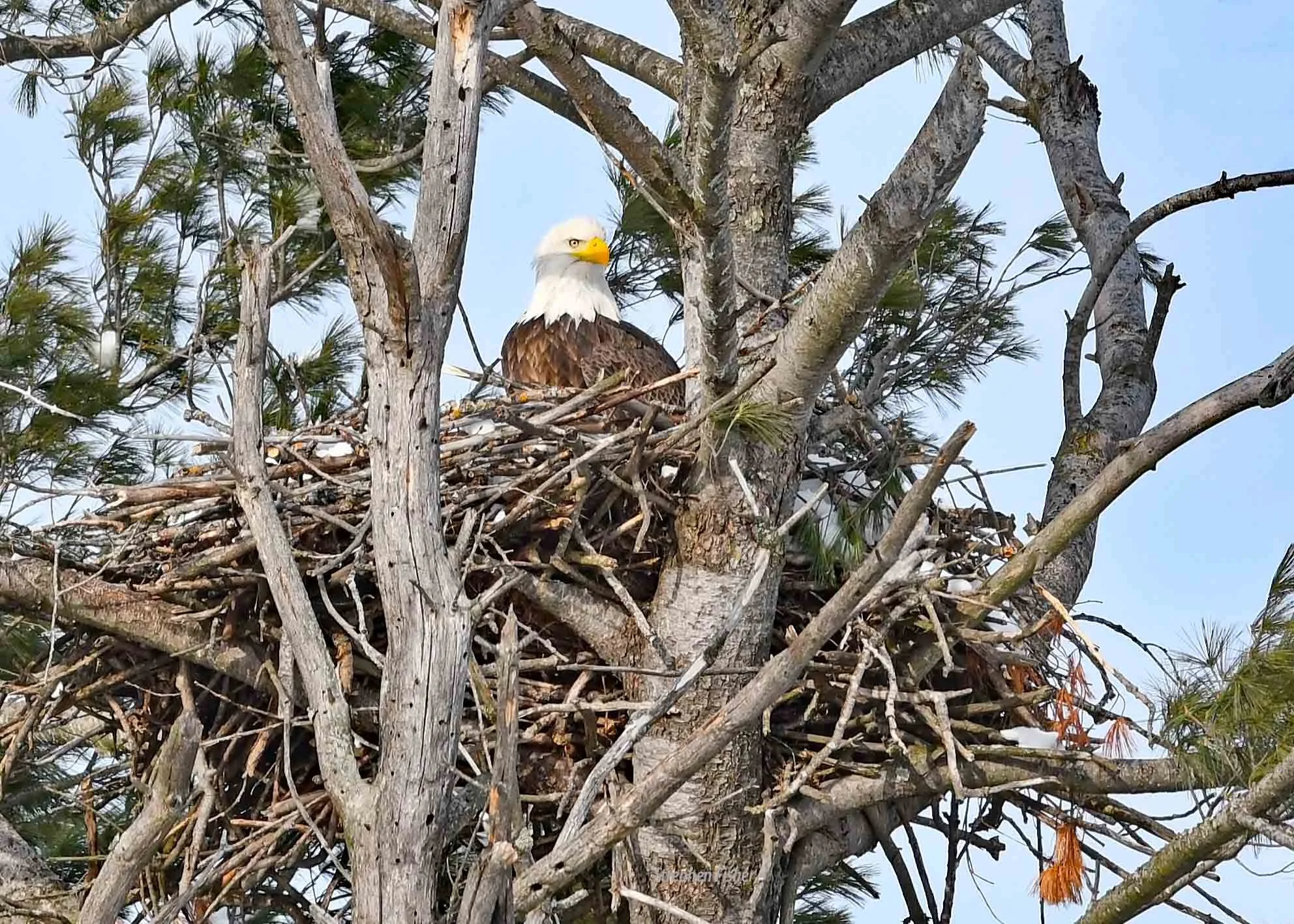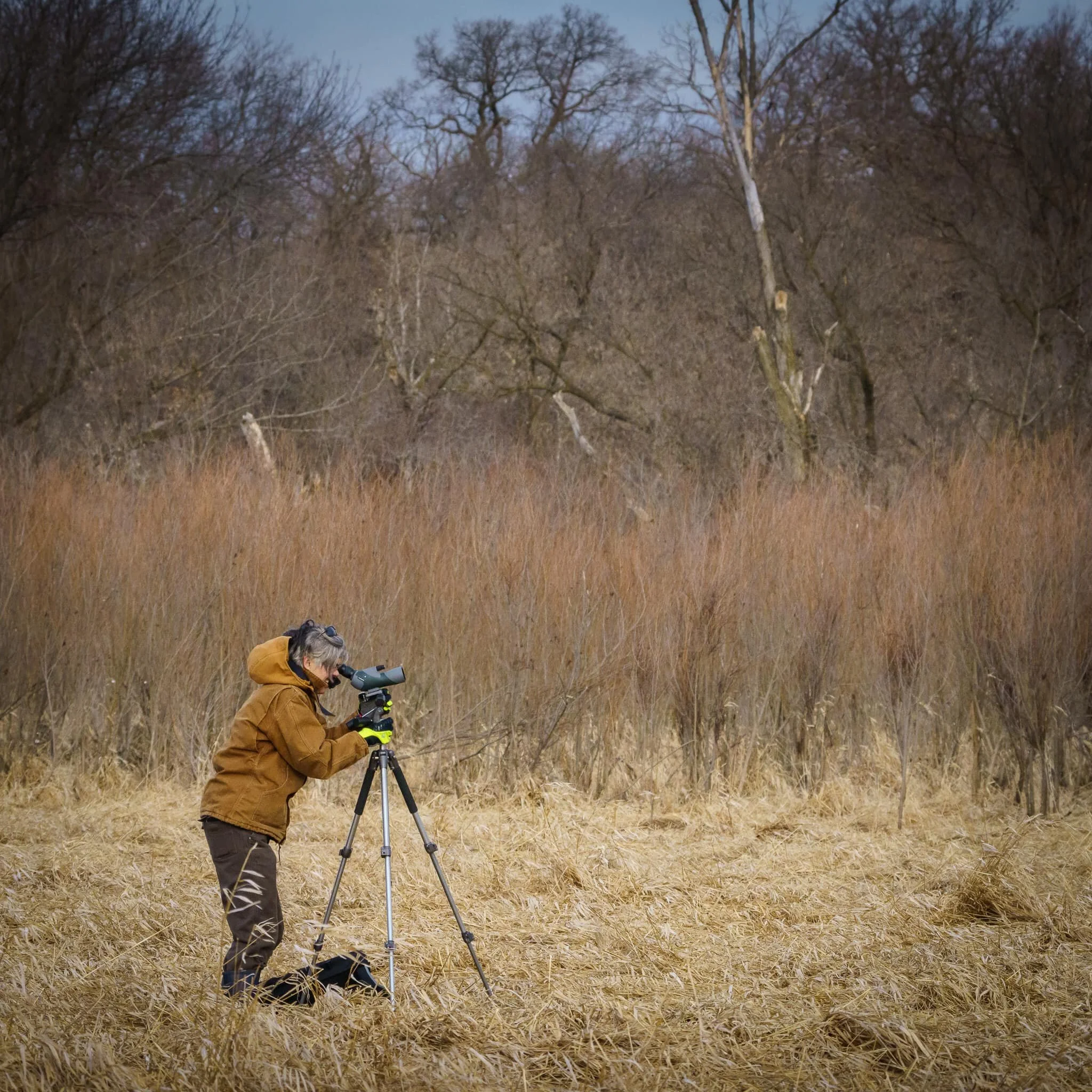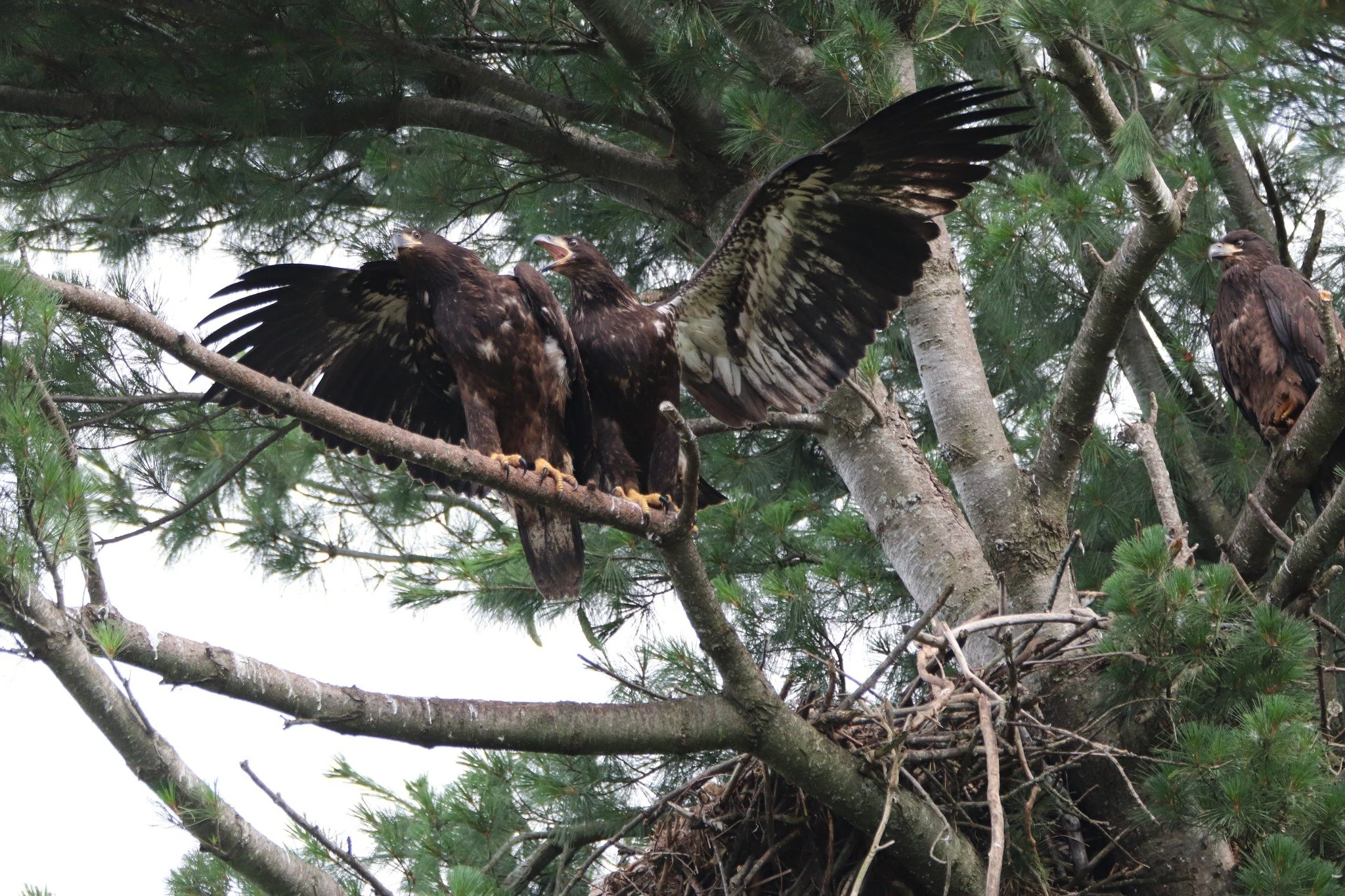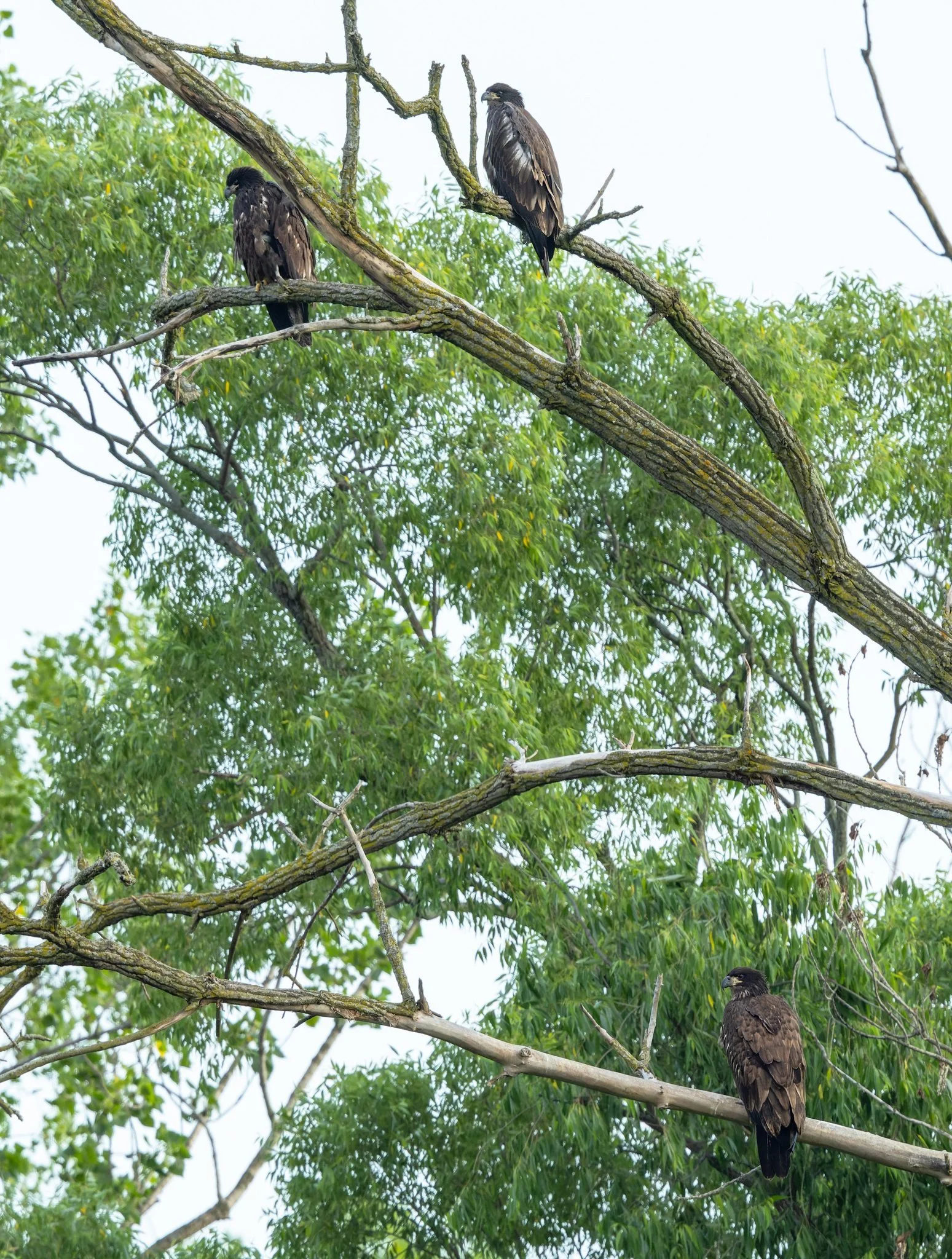Adult Bald Eagle in a nest (photo by Steve Fisher, BENW volunteer in the Central WI program)
Another Bald Eagle nesting season is in the books. . . well, mostly. Of the 267 active Bald Eagle nests that volunteers throughout the state were monitoring, only ONE still has eaglets in the nest!
It was another amazing year of dedicated volunteers putting in thousands of hours monitoring the Bald Eagle nests they were assigned to, and documenting the fate of those nests. It’s a program that spans the seasons from the frozen, wind-swept landscapes of frozen February when nesting begins, through the birdsongs and ice-offs of spring, and into heat waves and buzzing (and biting) insects of July when eaglets fledge. And even after the leaves fall in autumn, many eagle watchers are out again, looking for new nests.
Why do these volunteers spend so much time out in the woods, staring at these piles of sticks?
Bald Eagle Nest Watch volunteer setting up their spotting scope to watch a nest (photo by Lisa Frank, BENW volunteer in southern Wisconsin)
First, because they’re filling a big gap in data.
Prior to 2020, the Wisconsin DNR conducted aerial surveys in airplanes, flying over all of the known Bald Eagle nests in Wisconsin, documenting occupancy, and again later in the spring, success rates of the nests. Starting in 2020, DNR began scaling back its efforts and eventually discontinuing surveys, in large part because eagles were such a success story for conservation. As a result, the volunteers in Bald Eagle Nest Watch are the primary (and possibly only) people systematically gathering data about Bald Eagle reproduction in Wisconsin.
Second, because eagles still need protecting.
Bald Eagles almost faced extinction in the mid-1900s after the widespread use of DDT. Serious and difficult conservation efforts were put into action to reerse that trend, and it was successful. Bald Eagles were taken off the federal Endangered Species List in 2007, but remain on the Bald and Golden Eagle Protection Act. They face a variety of man-made threats, including being hit by cars, lead poisoning, habitat destruction, and poaching. It took SO much work to bring them back from the brink, and we believe we cannot let their populations backslide. Our volunteers help determine if there are threats at particular nests or changes in populations over all that need to be addressed.
A volunteer and his granddaughter monitor an eagle nest together (photo by Lyn Boyde, BENW volunteer in the Southern program)
Third, eagles are a great introduction to conservation.
Many of our volunteers come to us not as extraordinary birders, but folks interested in eagles and nature. Through their experiences each week, in the quiet of their site, watching the eagles and meanwhile hearing the frogs begin to sing and the migratory birds return from the south, they enjoy the benefits of being closely tuned into nature. Eagles are large, easy to identify, and fun to watch—what better bird to bring folks into community with conservation?
Fourth, it’s plain and simple FUN!
Many of our volunteers have the pleasure of watching a Bald Eagle family grow, with adults laying and incubating eggs, soon with wobbly fluffy gray heads poking up over the nest edge, and eventually big dark brown eaglets taking their first flight. Our volunteers have fun with it, taking photos, journaling, socializing in their social media groups, and sharing stories. And we enjoy working with them and hearing their stories as well!
The Bald Eagle Nest Watch program is comprised of eight program areas, described at the bottom of this article. We are so grateful to our amazing program partners who make all this work possible!
Some of the data are still coming in, and as I mentioned early on, one nest still has nestlings! That’s not typical for Wisconsin, as eagles begin nesting early to allow their nestlings to fledge before the heat and biting flies become too much. But at this particular nest, the first clutch of eggs failed and the adults relaid, so the two eaglets in that nest are late bloomers!
An empty nest (photo by Sandeep Tannu, BENW volunteer in the Southern program)
Overall summary (all programs, combined):
A total of 585 volunteers
At least 5,997 hours of nest monitoring completed in 2025!
Nests in 46 counties monitored (over half of WI counties)
267 nests monitored
299 eaglets successfully fledged in 2025
55 nests failed (representing a 19.9% failure rate—yearly average is 15%). We believe this rate was above average due to the number of large, destructive storms in spring (rain + strong winds)
11 nests with unknown outcomes (the nest was completely obscured by leaves by the end of the season, or the volunteer was unable to continue monitoring)
Number of nests that needed rescue missions: none! (Phew!! We love that)
184 nests successful with fully fledged young
Number of successful nests that fledged three young: 15 (8%)
Number of successful nests that fledged two young: 87 (48%)
Number of successful nests that fledged one young: 80 (44%)
Three eaglets sitting on branches the nest, with one eaglet trying hard to annoy its sibling (photo by Lisa Pearson, BENW volunteer in the Eau Claire/Chippewa area program)
Each of the 8 program area’s results
1 - Central area program summary:
Includes nests in Marathon, Portage, Sawyer, Waupaca, Waushara, and Wood Counties. Led this year by yours truly (though usually someone who lives in the central part of the state).
22 volunteers
367 hours of monitoring reported
18 nests monitored
22 eaglets fledged
3 nest failures
0 nests with unknown outcomes
2 - Door County area Program Summary:
Includes nests in Door and Kewaunee Counties. Led by Tony Kiszonas and Sam Hoffman at The Ridges Sanctuary.
30 volunteers
312 hours of monitoring reported
12 nests monitored
At least 16 eaglets fledged (three nests still need to report data)
1 nest failure
2 nests with unknown outcomes
3 - Eau Claire/Chippewa area Program Summary:
Includes nests in Chippewa, Dunn, Eau Claire, Jackson, and Rusk Counties. Led by Claire Molina, Breanne Klockzien, and Jeanette Kelley at Beaver Creek Reserve.
42 volunteers
375 hours of monitoring reported
20 nests monitored
22 eaglets fledged
6 nest failures
1 nest with unknown outcomes
One adult sitting in the nest and another flying in with a fish (photo by Susan Fink, BENW volunteer in the Southeastern program)
4 - Fox Valley area program summary:
Includes nests in part of Calumet, part of Fond du Lac, Outagamie, and Winnebago Counties. Led by Brad Garrity at 1000 Islands Environmental Center
83 volunteers
682 hours of monitoring reported
24 nests monitored
31 eaglets fledged
4 nest failures
1 nest with unknown outcomes
5 - Manitowoc County area program summary:
Includes nests in Manitowoc and part of Calumet Counties. Led by Kennedy Zittel at Woodland Dunes Nature Center.
31 volunteers
195 hours of monitoring reported
8 nests monitored
8 eaglets fledged
2 nest failures
1 nest with unknown outcomes
6 - Northeastern area program summary:
Includes nests in Brown, Oconto, and Shawano Counties. Led by Logan Lasee at Brown County Parks.
36 volunteers
391 hours of monitoring reported
18 nests monitored
16 eaglets fledged
7 nest failures
2 nests with unknown outcomes
A young eaglet stretches its wings in the nest (photo by Susan Fink, BENW volunteer in the Southeastern program)
7 - Southeastern area program summary:
Includes nests in Kenosha, Milwaukee, Ozaukee, Racine, Walworth, Washington, and Waukesha Counties. Led by Beth Martin, volunteer and part of the Bald Eagle Socialites Club.
80 volunteers
924 hours of monitoring reported
37 nests monitored
47 eaglets fledged
9 nest failures
0 nests with unknown outcomes
8- Southern area program summary:
Includes nests in Adams, Columbia, Dane, Dodge, part of Fond du Lac, Grant, Green, Green Lake, Iowa, Jefferson, Juneau, Lafayette, Marquette, Richland, Rock, Sauk, Sheboygan, and Vernon Counties. Led by Drew Cashman, volunteer with Southern Wisconsin Bird Alliance, and me.
257 volunteers
2,751 hours of monitoring reported
135 nests monitored
At least 141 eaglets fledged (waiting on info from a few more nests)
29 nest failures
4 nests with unknown outcomes
Three fledgling eaglets sit on branches near each other (photo by Beth Bush, BENW volunteer in the Southeastern program)
Truly, this program is completely and utterly impossible without the generosity of our volunteers, who give their time and energy to the eagle families they monitor. We are also incredibly grateful to the property owners and managers we work with who allow us access to their land so we can monitor the nests. And huge thank you to our area leads and organizational partners who recruit volunteers, manage the program, and provide local help for all of these areas. This is an amazing community to be a part of, all for the love of eagles!
If you are interested in joining Bald Eagle Nest Watch in 2026, keep an eye on our webpage in December when we open registration to new volunteers.
In the meantime, keep your eye out for big, dark brown eagles flying around Wisconsin this summer—they are likely ones that recently fledged!
Written by Brenna Marsicek, statewide coordinator of BENW, southern area co-lead, and central area lead, Southern Wisconsin Bird Alliance director of outreach











